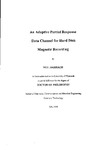An Adaptive Partial Response Data Channel for Hard Disk Magnetic Recording
| dc.contributor.author | DARRAGH, NEIL | |
| dc.contributor.other | School of Engineering, Computing and Mathematics | en_US |
| dc.date.accessioned | 2013-11-05T11:03:05Z | |
| dc.date.available | 2013-11-05T11:03:05Z | |
| dc.date.issued | 1994 | |
| dc.identifier | NOT AVAILABLE | en_US |
| dc.identifier.uri | http://hdl.handle.net/10026.1/2594 | |
| dc.description.abstract |
An adaptive data channel is proposed which is better able to deal with the variations in performance typically found in the recording components of a hard disk drive. Three such categories of variation were investigated in order to gain an understanding of their relative and absolute significance; variations over radius, along the track length, and between different head / media pairs. The variations were characterised in terms of their effects on the step-response pulse width and signal-to-noise ratio. It was found that in each of the categories investigated, significant variations could be found in both longitudinal and perpendicular recording systems which, with the exception of radial variations, were nondeterministic over different head / media pairs but were deterministic for any particular head / media pair characterised. Conventional data channel design assumes such variations are non-deterministic and is therefore designed to provide the minimum error rate performance for the worst case expected recording performance within the range of accepted manufacturing tolerance. The proposed adaptive channel works on the principle that once a particular set of recording components are assembled into the disk drive, such variations become deterministic if they are able to be characterised. Such ability is facilitated by the recent introduction of partial response signalling to hard disk magnetic recording which brings with it the discrete-time sampler and the ability of the microprocessor to analyse signals digitally much more easily than analogue domain alternatives. Simple methods of measuring the step-response pulse width and signal to noise ratio with the partial response channel's electronic components are presented. The expected error rate as a function of recording density and signal to noise ratio is derived experimentally for the PR4 and EPR4 classes of partial response. On the basis of this information and the recording performance it has measured, the adaptive channel is able to implement either PR4 or EPR4 signalling and at any data rate. The capacity advantage over the non-adaptive approach is investigated for the variables previously identified. It is concluded on the basis of this investigation that the proposed adaptive channel could provide significant manufacturing yield and capacity advantages over the non-adaptive approach for a modest increase in electronic complexity. | en_US |
| dc.language.iso | en | en_US |
| dc.publisher | University of Plymouth | en_US |
| dc.title | An Adaptive Partial Response Data Channel for Hard Disk Magnetic Recording | en_US |
| dc.type | Thesis | |
| plymouth.version | Full version: final and full version as approved by the examiners at the time of the award of your degree | en_US |
| dc.identifier.doi | http://dx.doi.org/10.24382/3904 | |
| dc.identifier.doi | http://dx.doi.org/10.24382/3904 |
Files in this item
This item appears in the following Collection(s)
-
01 Research Theses Main Collection
Research Theses Main


